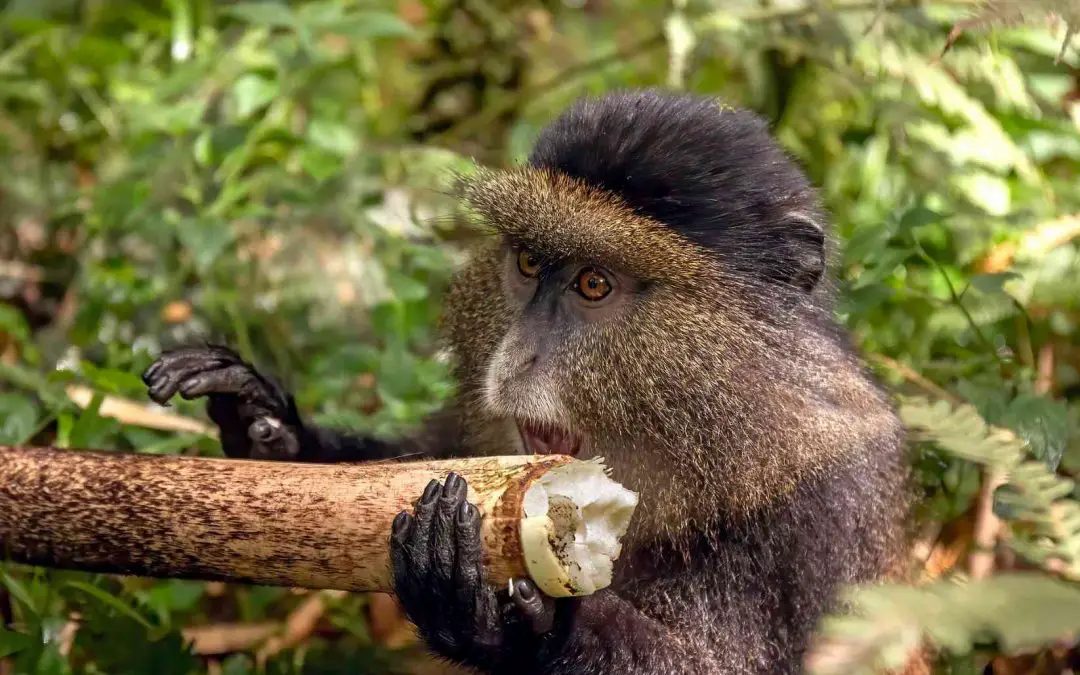Because of my fervent interest and broad knowledge regarding the subject of bamboo, I’ve actually had a few people ask me if I’m a distant relative of the Giant Panda Bear. In fact, despite my love of bamboo, there are no pandas among my recent ancestors. As a primate, I am more closely related to another furry bamboo enthusiast, and that’s the Golden Monkey of Central Africa.
The Golden Bamboo Monkey, Cercopithecus kandti, commonly known simply as the Golden Monkey, has a very limited distribution in the Virunga Mountains of Central Africa, where it subsists on a diet of bamboo and fresh fruit. Listed as endangered by the International Union for Conservation of Nature (IUCN), most Golden Monkeys now live in the four national parks encompassed by this chain of volcanic mountains. The monkeys seasonally migrate back and forth across the mountain range, strongly favoring those areas where the bamboo is most abundant.
This is part of an ongoing series about bamboo and wildlife. Bamboo is vital component in a wide variety of ecosystems around the world. Many species of animal depend on bamboo for food or shelter, or else have earned some kind of bamboo nickname for other reasons. To learn more, check out some of these other interesting articles.
- Pandas bears, bamboo and other endangered species
- Bamboo sharks
- Bamboo partridges
- Reforestation and Bamboo
Characteristics of Golden Monkeys
The Golden Monkey is a singular species of Old World monkey, Cercopithecus kandti, a very close relative of the Blue Monkey (Cercopithecus mitis). The Blue Monkey has several subspecies, and until recently, the Golden Monkey was regarded as one of its subspecies.
The Golden Monkey is chiefly distinguishable by the orange (golden) streak of hair on its back. Blue Monkeys and Golden Monkeys have a pretty similar area of distribution, but the Blue Monkeys are not listed as endangered.
Members of the genus Cercopithecus are more generally referred to as guenons. Other relatives in this genus include the Silver monkey, the Diana monkey, Sykes monkeys and several species of Mona monkeys. Most of them have small distributions, all in sub-Saharan Africa. And like the Golden Monkey, many of these species are endangered.
Range and Distribution of the Golden Bamboo Monkeys
The Golden Monkeys live in a very particular area among the high forests of Central Africa. Specifically, they tend to dwell on the slopes of the Virunga volcanic mountains. Shrinking habitat, resulting from hunting, poaching, and other human activities, has driven most of the Golden Monkeys into one of the four national parks of this volcanic mountain range.
These protected areas include Mgahinga Gorilla National Park in Uganda, Volcanoes National Park in Rwanda, and Kahuzi-Biéga and Virunga National Parks, both in the Democratic Republic of the Congo. These parks are also home to a rich diversity of flora and fauna, including the critically endangered Mountain Gorillas. Like the monkeys, these great apes depend on the native bamboo that flourishes in these equatorial highlands.
Dian Fossey, of Gorillas in the Mist fame, brought international attention to this area and the plight of the gorillas. She established the Karisoke Research Center in Volcanoes National Park in 1967, and it remains operational to this day.
The Golden Monkey’s Diet
The Golden Monkey eats tropical fruit and leaves, but its favorite meal is bamboo. There are several species of bamboo native to Africa, and African Alpine Bamboo is the most common in this region. Yushania alpina, as its botanically known, grows in the highlands of Central Africa and the East Africa Rift, at altitudes of around 8-10,000 feet. You can also find Oxytenanthera abyssinica, probably the most widespread bamboo on the continent, growing among these mountains.
Based on limited observation of the Golden Monkey, bamboo seems to be the most preferred item on its menu. The monkeys are especially interested in the fresh shoots, which sprout up at the beginning of the growing season. Thus, the hungry monkeys will migrate according to the seasons to reach the most plentiful bamboo shoots at the best time of year. At other times of year, certain types of fruit are more abundant.
Conservation efforts
The establishment of these four national parks has made a tremendous difference for the survival of the Golden Monkeys by providing them a safe haven within their native habitat. Protected from hunters and poachers, as well as the civil wars that have ravaged this region, the Golden Monkeys are able to go about their business in relative tranquility.
In addition to offering these protected areas within the parks, conservationists have also been conducting a campaign to plant more bamboo in these mountainsides. Larger and more numerous groves of Alpine Bamboo make it easier for the monkeys and the mountain gorillas to find that exalted delicacy on which they both depend.
Naturally curious?
Are you fascinated by nature, wildlife and all things bamboo? And curious to learn more? Check out some of these other in-depth articles and expand your knowledge.

























